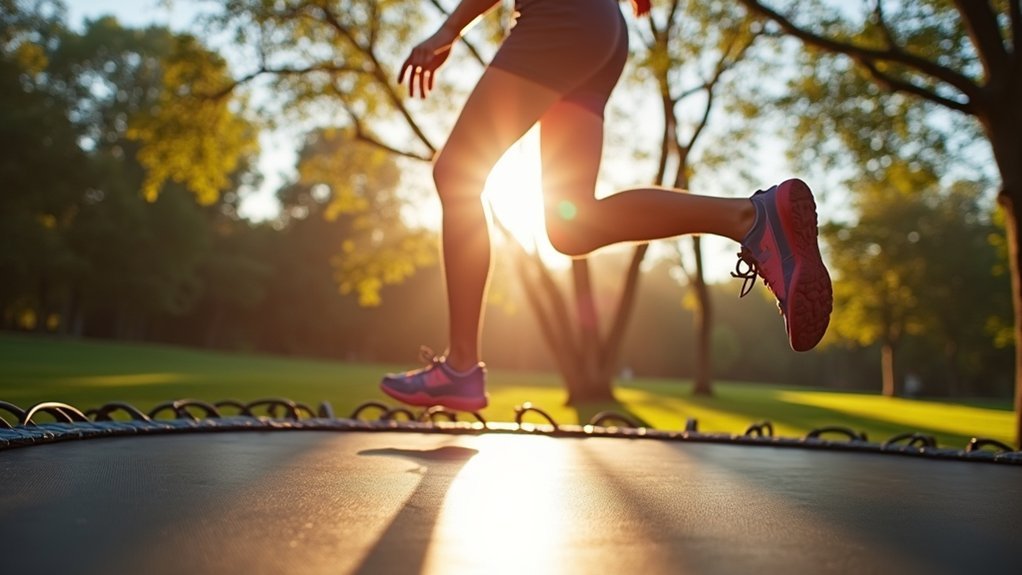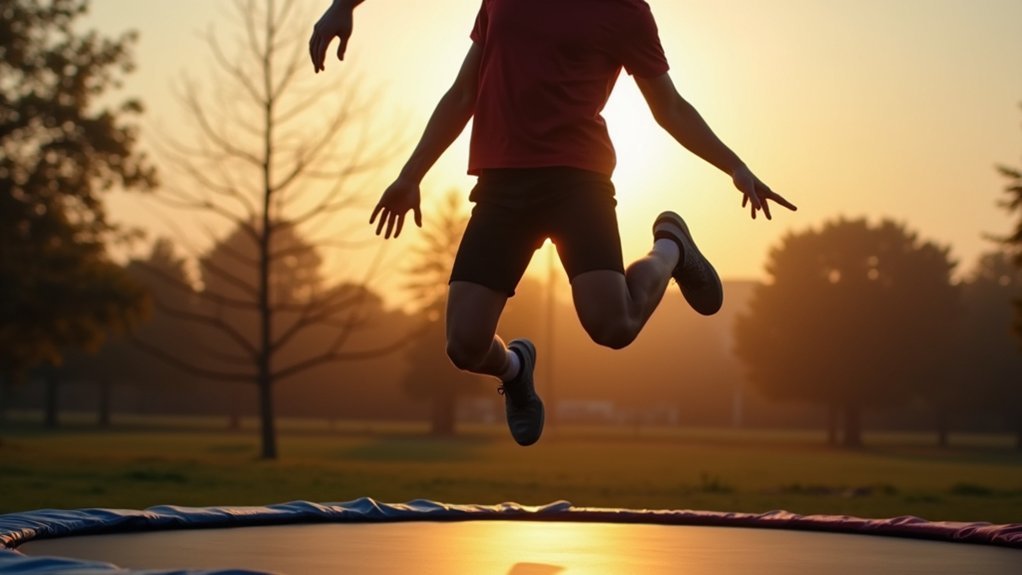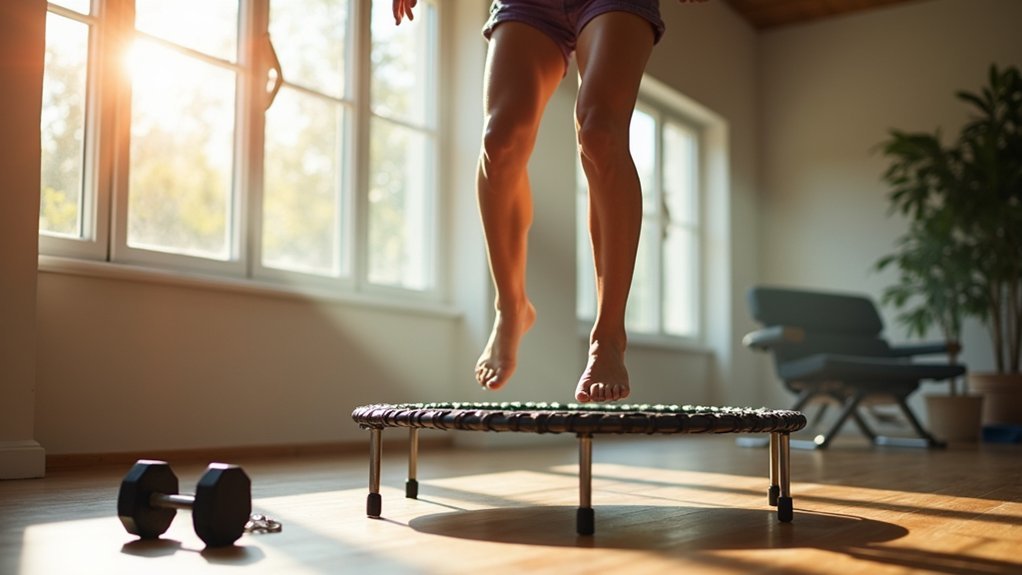Rebounding strengthens your hip bones in five key ways: it creates ideal impact forces that stimulate bone growth, activates osteoblasts for new bone formation, engages hip-supporting muscles, improves balance to prevent falls, and offers joint-friendly alternatives to high-impact exercises. You’ll experience these benefits with just minutes of daily bouncing on a mini-trampoline. The science behind these hip-strengthening mechanisms reveals why rebounding has become a top choice for bone health.
The Science Behind Impact Forces and Bone Density

While many forms of exercise benefit your overall health, rebounding offers unique advantages for your hip bones. When you jump on a rebounder, you create mechanical loading through impact forces that directly stimulate bone remodeling processes in weight-bearing areas like your hips.
These forces trigger increased osteoblast activity—the cells responsible for building new bone tissue. What makes rebounding particularly effective is that the landing force can exceed that of other low-impact exercises, providing the best stimulus for bone strengthening without joint stress.
When you rebound, you maximize osteoblast stimulation while protecting your joints—the perfect formula for stronger hip bones.
Your skeletal system adapts to these varying impact forces by increasing bone density over time. This adaptation is vital, especially as you age.
The controlled bouncing motion guarantees you’ll receive adequate bone-strengthening benefits while minimizing injury risk—making rebounding an ideal exercise for maintaining hip bone density throughout your life.
How Rebounding Stimulates Osteoblast Activity in Hip Bones
When you bounce on a rebounder, your hip bones experience a cellular awakening that directly benefits your skeletal health. Each gentle impact triggers your osteoblasts—the cells responsible for building bone—to spring into action.
| Rebounding Mechanism | Osteoblast Response |
|---|---|
| Mechanical loading | Increased cell proliferation |
| Gentle impact forces | Release of growth factors |
| Rhythmic movement | Enhanced mineralization |
Rebounding helps stimulate these bone-building cells without harsh impact on your joints. The pressure and tensile forces applied during jumping directly signal your osteoblasts to strengthen your hip bone matrix. This cellular stimulation is particularly valuable as you age, when maintaining bone density becomes more challenging. You’re fundamentally giving your hip bones a workout at the cellular level, potentially reducing osteoporosis risk while enjoying a low-impact exercise suitable for most fitness levels.
Muscle Engagement Around Hip Joints During Rebounding

Rebounding creates a symphony of muscle activity around your hip joints with each bounce you take. Your glutes, hip flexors, and quadriceps work in concert to stabilize your hips through each movement, building muscle strength while protecting your joints.
As you bounce, your hip abductors and adductors activate continuously, enhancing hip stability and reducing injury risk. This dynamic engagement doesn’t just strengthen muscles—it supports bone density through gentle resistance that won’t stress your joints.
You’ll develop greater muscular endurance around your hips with regular rebounding, improving your balance and coordination.
For older adults especially, this increased strength helps prevent falls and fractures by creating a protective muscular framework around vulnerable hip joints, all while enjoying a low-impact exercise that’s gentle on your body.
Balance and Coordination Benefits for Hip Stability
Balance and coordination emerge as powerful protective factors for your hip joints when you practice rebounding regularly. As you bounce, you’re engaging multiple muscle groups simultaneously, enhancing your hip stability naturally.
Your body learns to better sense its position through improved proprioception, greatly reducing your fall risk – an essential benefit for protecting hip bones.
When you rebound, you’re activating core muscles that directly support hip stability during everyday movements. The dynamic nature of this exercise develops neuromuscular coordination that translates to better functional movement patterns in your daily activities.
Research shows these balance and coordination improvements are particularly valuable for older adults, as they dramatically decrease fall incidents that often lead to devastating hip fractures.
Your hip stability improves with each bouncing session.
Comparing Rebounding to Traditional Hip-Strengthening Exercises

Unlike traditional hip exercises that often strain joints, rebounding offers a gentler yet effective alternative for strengthening hip bones.
While squats and lunges place significant pressure on your hips, the mini-trampoline’s soft, rhythmic bouncing motion engages the same muscles with minimal impact.
You’ll work your hip flexors and glutes thoroughly through rebounding, rather than isolating specific muscles as in traditional hip-strengthening exercises.
This full engagement promotes better balance and stability—crucial elements for long-term hip health.
Though rebounding hasn’t been conclusively proven to increase bone density, it delivers substantial benefits that traditional exercises might not: improved coordination, muscle strength, and joint mobility—all without the wear and tear.
You’re fundamentally training your hip muscles while giving your joints a much-needed break from high-impact stress.
Frequently Asked Questions
Does Rebounding Strengthen Hips?
Yes, rebounding can strengthen your hips. You’ll improve bone density through weight-bearing impacts while engaging hip muscles. It’s low-impact, making it gentler on your joints than many other exercises.
Can a Rebounder Improve Bone Density?
While you might enjoy rebounding for fitness, evidence for bone density improvement is inconclusive. Studies show mixed results, and traditional weight-bearing exercises may be more effective for strengthening your bones, especially if you’re older.
How Can I Make My Hip Bones Stronger?
To strengthen your hip bones, incorporate weight-bearing exercises like walking or stair climbing. You’ll benefit from resistance training, adequate calcium and vitamin D intake, and maintaining a healthy weight. Don’t forget regular bone density screenings.
What Is 10 Minutes on a Rebounder Equivalent To?
Ten minutes on a rebounder is equivalent to about 30 minutes of traditional low-impact aerobic exercise. You’ll burn approximately 100 calories while engaging multiple muscle groups and boosting your lymphatic system, all with minimal joint stress.
In Summary
You’re investing in your long-term mobility with every bounce. By stimulating bone growth through gentle impact, activating hip muscles, and improving your balance, rebounding offers a thorough approach to hip health. It’s gentler than traditional exercises yet equally effective at strengthening these essential joints. Start with short sessions and you’ll build stronger hips while enjoying a workout that doesn’t feel like work.



Leave a Reply